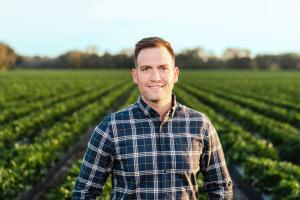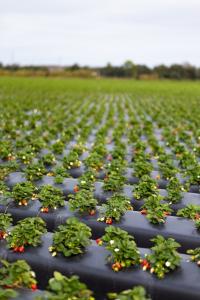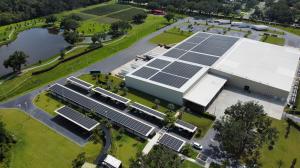Fourth Generation Family Farm Goes Solar with Rural Energy for America Program (REAP) Grant
Fourth Generation Family Farm Goes Solar with Rural Energy for America Program (REAP) Grant
For rural businesses considering solar, Nick offers clear advice, “It’s worth taking a look at. Solar energy is a reliable technology that can help save costs and improve efficiency on the farm.””
WASHINGTON, DC, UNITED STATES, June 27, 2024 /EINPresswire.com/ -- Wish Farms, a fourth-generation family business, has been a staple in the produce industry for over 100 years. Founded by Harris Wishnatzki, a Jewish-Ukrainian immigrant who escaped Eastern Europe in 1904, the company has grown from a humble push cart operation in New York to a leading berry supplier with operations in Florida, California, and Mexico.— Nick Wishnatzki, Public Relations Manager for Wish Farms
Nick Wishnatzki, Public Relations Manager for Wish Farms, and great-grandson of Harris, shared insights into the company’s journey and recent ventures, particularly their significant investment in solar energy.
Nick’s great-grandfather moved to central Florida, to Lakeland, in 1929, establishing roots in what is now known as the winter strawberry capital of the world.
“Plant City became a thriving agricultural hub thanks to the railroad,” Nick explained. “Henry Plant’s railroad system allowed farmers to transport their produce up north, turning Plant City into a bustling center for strawberry farming.”
Having lived and grown up around the business his entire life, Nick feels a profound sense of pride and responsibility in continuing his family’s legacy.
"Being a part of a business that's been in my family for four generations is incredibly fulfilling," he said.
Despite its rich history and robust market, berry farming comes with its own set of challenges. One of the most pressing issues is the availability of labor.
“Harvesting berries is labor-intensive, requiring skilled workers to pick the crop every three days,” Nick noted.
Nick remains hopeful about technological advancements that could ease some of these challenges.
“Gene editing and disease-resistant plants are promising developments that could help reduce the need for chemicals, improvise yields, make farming more sustainable as well as other efficiencies,” he said.
In 2022, Wish Farms installed a rooftop solar system to power their operations, a decision driven by both environmental and economic considerations. The system, installed by SEM Power, consists of 2,100 panels and covers 80,000 square feet in total, producing an impressive 1.6 million kWh annually.
“We had a lot of real estate on top of our cooling facilities, and it just made sense to utilize that space,” Nick explained. “Cooling is a big part of our operation, and it’s very energy-intensive. By going solar, we’re doing the right thing for the environment and saving money in the long run.”
The decision to go solar wasn’t made lightly. Nick emphasized the importance of ensuring a fair payback period and the durability of the solar panels.
“We wanted to make sure it was a good investment,” he said. “So far, it has proven to be a wise choice.”
The installation process occurred in two phases, with the initial 20,000 square feet of panels installed in February 2020 and an additional 60,000 square feet added later. Although supply chain issues delayed the activation of the system, it is now fully operational and significantly contributing to the operation’s energy needs.
“We believe it will cover about 50-70% of our energy requirements,” Nick estimated.
Wish Farms’ solar project was partially funded through the Rural Energy for America Program (REAP) grant, a federal initiative aimed at promoting renewable energy in rural areas.
“The grant definitely played a part in our decision to go solar,” Nick said. “We made connections with the USDA and knew about the incentives available. They were able to help us understand the process. The payback was viable even without the grant, but it certainly made the decision easier.”
For other rural businesses considering solar energy, Nick offers clear advice, “It’s worth taking a look at. Solar energy is a reliable technology that can help save costs and improve efficiency on the farm. If the numbers make sense, it can be a beneficial investment.”
As Wish Farms continues to innovate and adapt, Nick remains committed to honoring the legacy of his great-grandfather while embracing modern advancements.
“We’ve come a long way from push carts,” he reflected. “And we’re excited to see where the next 100 years will take us.”
As part of its mission to help people go solar, the national nonprofit Solar United Neighbors (SUN) has developed a 10-week program that helps walk farmers and rural small business owners through the REAP application process.
“Whether you’re a small business owner or you own a farm, the Rural Energy for America Program could be your key to unlocking the power of solar energy. Going solar is not just about saving money; it's about enhancing your operational goals, promoting energy independence, and boosting local economies,” said Anya Schoolman, Solar United Neighbors Executive Director.
REAP offers grants and loans to make solar more affordable. These grants are for up to 50% of the system cost and loans are available through a competitive application process. The Inflation Reduction Act quadrupled funding for the program. The next deadline to apply for REAP funding in 2024 is September 30.
Those interested in assistance can join Ready, Set, Solar, REAP online: Ready, Set, Solar! https://www.solarunitedneighbors.org/ready-set-solar-rural-businesses/
As part of the program participants receive:
-A week of emails introducing the REAP grant process and a REAP guide, followed by an email a week with bite-size to-do’s for the remaining nine weeks
-Unbiased, installer-neutral advice and expertise
-Support from a network of peers, including SUN staff and previous REAP grantees
Additional REAP resources provided by SUN include:
-An on-demand webinar ‘REAP Solar Grants & Your Rural Business’ https://www.youtube.com/watch?v=43ckopX_5M8, in English https://go.solarunitedneighbors.org/e/941793/43ckopX-5M8/ch1wk/239372662?h=OkiPWAXh3rvIH35xcivS59qvdmXKN3UAKmM0EL7uUA8 and Spanish https://go.solarunitedneighbors.org/e/941793/q-w6h7u4sGQ/ch1wn/239372662?h=OkiPWAXh3rvIH35xcivS59qvdmXKN3UAKmM0EL7uUA8
-REAP guide in English https://www.solarunitedneighbors.org/download-our-rural-business-guide/ & Spanish https://www.solarunitedneighbors.org/descarga-nuestra-guia-de-negocios-rurales/
-Solar Help Desk with hands-on support https://www.solarunitedneighbors.org/go-solar/want-to-install-solar/go-solar-on-your-own/
-USDA website map to see if a rural business is in an eligible area (NOTE: qualifying farms are available regardless of location) https://eligibility.sc.egov.usda.gov/eligibility/welcomeAction.do?pageAction=rbs
-USDA REAP FAQ (at the bottom of the page) https://www.rd.usda.gov/inflation-reduction-act/rural-energy-america-program-reap
Janelle Darst
None
+1 3192312435
email us here
Visit us on social media:
Facebook
X
LinkedIn
Instagram
YouTube
Legal Disclaimer:
EIN Presswire provides this news content "as is" without warranty of any kind. We do not accept any responsibility or liability for the accuracy, content, images, videos, licenses, completeness, legality, or reliability of the information contained in this article. If you have any complaints or copyright issues related to this article, kindly contact the author above.



